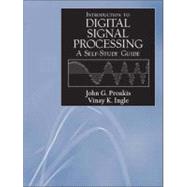The Study Guide is intended for use as a companion for self-study to the textbook entitled Digital Signal Processing, Principles, Algorithms, and Applications, Third Edition, published by Prentice Hall. MATLAB is incorporated as the basic software tool for this self-study guide. The Study Guide, along with the textbook, can be used by students, practicing engineers, and scientists who wish to obtain an introduction to the subject. It can also be used by people who have had a basic undergraduate course in DSP but who have not been exposed to DSP software tools, such as MATLAB, for analyzing and implementing DSP systems and algorithms.
For effective learning of the material and for understanding difficult concepts in DSP, it is important to integrate software tools with textual study. This integration makes it possible for students to simulate signals, systems (or filters), or algorithms and provides for "what-if" type of analyses to delve more deeply into the topics. This Study Guide, designed with this approach in mind, uses MATLAB as the tool. In addition to learning each topic, concept, or algorithm, the student should make every effort to use the provided MATLAB functions to develop a stronger intuition and a deeper understanding of the material.
The Study Guide treats traditional topics covered in an introductory DSP course. In each chapter of the Study Guide, the reader is directed to review the topics covered in the corresponding chapter of the textbook. The basic topics and results treated in each chapter of the textbook are summarized in the Study Guide, and the relevant MATLAB functions to be used in solving problems are introduced. At the end of each chapter of the Study Guide is a set of problems that the reader should solve, using MATLAB. Solutions to these problems are included in the Study Guide.
The DSP textbook also contains numerous problems at the end of each chapter. Many of these problems can also be solved by using MATLAB. If additional practice is desirable, the reader is encouraged to solve some of these problems in MATLAB.
The various MATLAB functions cited in the Study Guide are available at the location
ftp://ftp.cdsp.neu.edu/pub/ingle/I&P_dsp_toolbox
These functions require MATLAB version 5 or higher and the signal toolbox version 3 or higher. Further information about MATLAB and the related toolbox can be obtained from the MathWorks, Inc.
A self contained, more in-depth treatment of the use of MATLAB in the analysis and design of digital-signal processing systems and algorithms is given in the book Digital Signal Processing using MATLAB, written by Vinay K. Ingle and John G. Proakis, and published by Brooks Cole, Thomson Learning.
JOHN G. PROAKIS
VINAY K. INGLE
Boston, Massachusetts








